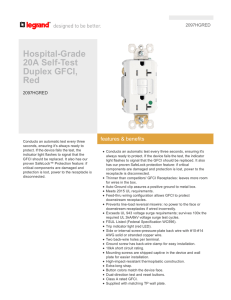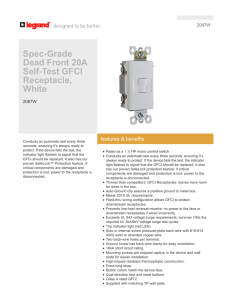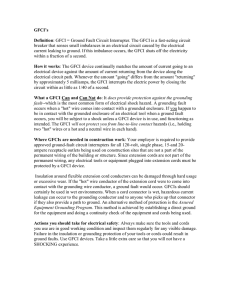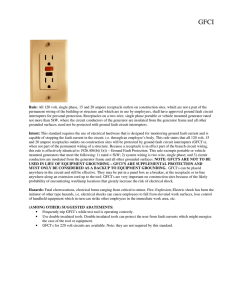Information Sheet # 08
advertisement
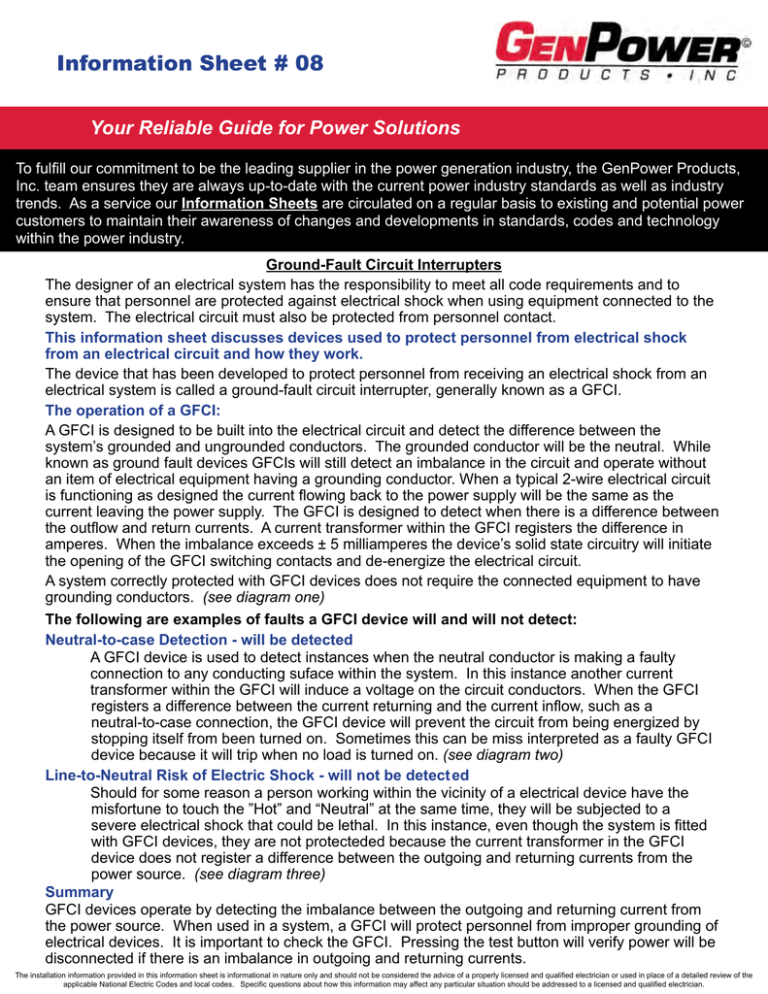
Information Sheet # 08 Your Reliable Guide for Power Solutions To fulfill our commitment to be the leading supplier in the power generation industry, the GenPower Products, Inc. team ensures they are always up-to-date with the current power industry standards as well as industry trends. As a service our Information Sheets are circulated on a regular basis to existing and potential power customers to maintain their awareness of changes and developments in standards, codes and technology within the power industry. Ground-Fault Circuit Interrupters The designer of an electrical system has the responsibility to meet all code requirements and to ensure that personnel are protected against electrical shock when using equipment connected to the system. The electrical circuit must also be protected from personnel contact. This information sheet discusses devices used to protect personnel from electrical shock from an electrical circuit and how they work. The device that has been developed to protect personnel from receiving an electrical shock from an electrical system is called a ground-fault circuit interrupter, generally known as a GFCI. The operation of a GFCI: A GFCI is designed to be built into the electrical circuit and detect the difference between the system’s grounded and ungrounded conductors. The grounded conductor will be the neutral. While known as ground fault devices GFCIs will still detect an imbalance in the circuit and operate without an item of electrical equipment having a grounding conductor. When a typical 2-wire electrical circuit is functioning as designed the current flowing back to the power supply will be the same as the current leaving the power supply. The GFCI is designed to detect when there is a difference between the outflow and return currents. A current transformer within the GFCI registers the difference in amperes. When the imbalance exceeds ± 5 milliamperes the device’s solid state circuitry will initiate the opening of the GFCI switching contacts and de-energize the electrical circuit. A system correctly protected with GFCI devices does not require the connected equipment to have grounding conductors. (see diagram one) The following are examples of faults a GFCI device will and will not detect: Neutral-to-case Detection - will be detected A GFCI device is used to detect instances when the neutral conductor is making a faulty connection to any conducting suface within the system. In this instance another current transformer within the GFCI will induce a voltage on the circuit conductors. When the GFCI registers a difference between the current returning and the current inflow, such as a neutral-to-case connection, the GFCI device will prevent the circuit from being energized by stopping itself from been turned on. Sometimes this can be miss interpreted as a faulty GFCI device because it will trip when no load is turned on. (see diagram two) Line-to-Neutral Risk of Electric Shock - will not be detected Should for some reason a person working within the vicinity of a electrical device have the misfortune to touch the ”Hot” and “Neutral” at the same time, they will be subjected to a severe electrical shock that could be lethal. In this instance, even though the system is fitted with GFCI devices, they are not protecteded because the current transformer in the GFCI device does not register a difference between the outgoing and returning currents from the power source. (see diagram three) Summary GFCI devices operate by detecting the imbalance between the outgoing and returning current from the power source. When used in a system, a GFCI will protect personnel from improper grounding of electrical devices. It is important to check the GFCI. Pressing the test button will verify power will be disconnected if there is an imbalance in outgoing and returning currents. The installation information provided in this information sheet is informational in nature only and should not be considered the advice of a properly licensed and qualified electrician or used in place of a detailed review of the applicable National Electric Codes and local codes. Specific questions about how this information may affect any particular situation should be addressed to a licensed and qualified electrician. Notes on GFCI devices GFCI providing protection without equipment grounding conductor Power Input ● GFCI’s work by monitoring the imbalance between leaving and returning current. ● The GFCI was designed to protect personnel from electric shocks. ● GFCI electronics will allow operation with a differential in current as low as ± 5mA. ● A GFCI with an additional current transformer monitors faulty neutral to case contacts. ● GFCI’s will not protect a person from a shock should the hot and grounded neutral conductors be touched at the same time. The electric shock can be lethal. ● The electronics in a GFCI could be ruined by a high voltage spike generated by lighting. In this case personnel would not be protected. Diagram One GFCI Device Electronics to sense voltage difference and trip circuit 20 amps 19.995 amps Under normal conditions return current equals leaving current. When the GFCI electronics sense ± 5 mA difference between the circuits ungrounded and grounded neutral the device will open and de-energize circuit ON In this case a short to the motor housing caused a current differential of more than 5 mA and the GFCI opened the circuit before serious shock occurs OFF Copyright 2006 PLC Enterprises, LLC GFCI providing protection by sensing Neutral to Case Connection - Diagram Two Electronics to sense voltage difference and trip circuit Power Input GFCI Device Device Current transformer grounded to the neutral senses faulty current flow caused by faulty neutral connection to case. Stray wire grounding neutral to case Copyright 2006 PLC Enterprises, LLC GFCI Will Not Protect Line-to-Neutral Fault - Diagram Three Power Input Electronics to sense voltage difference and trip circuit GFCI Device GFCI Test Button Copyright 2006 PLC Enterprises, LLC ● The test button should be checked on a regular basis. With a Balanced Current the GFCI electronics do not detect any difference in leaving and returning current. The contacts remain closed providing no protection. ● Pushing the test button should turn off power to any connected load. Neutral ● Never assume the device is functioning unless it is tested. Hot WARNING - Shock could be lethal by touching line and neutral simultaneously Gen Power Products, Inc. ● 29905 Anthony Drive ● Wixom, MI 48393 ● Phone:(248) 624-7230 ● Fax: (248) 624-6940 ● www.genpowerproducts.com
